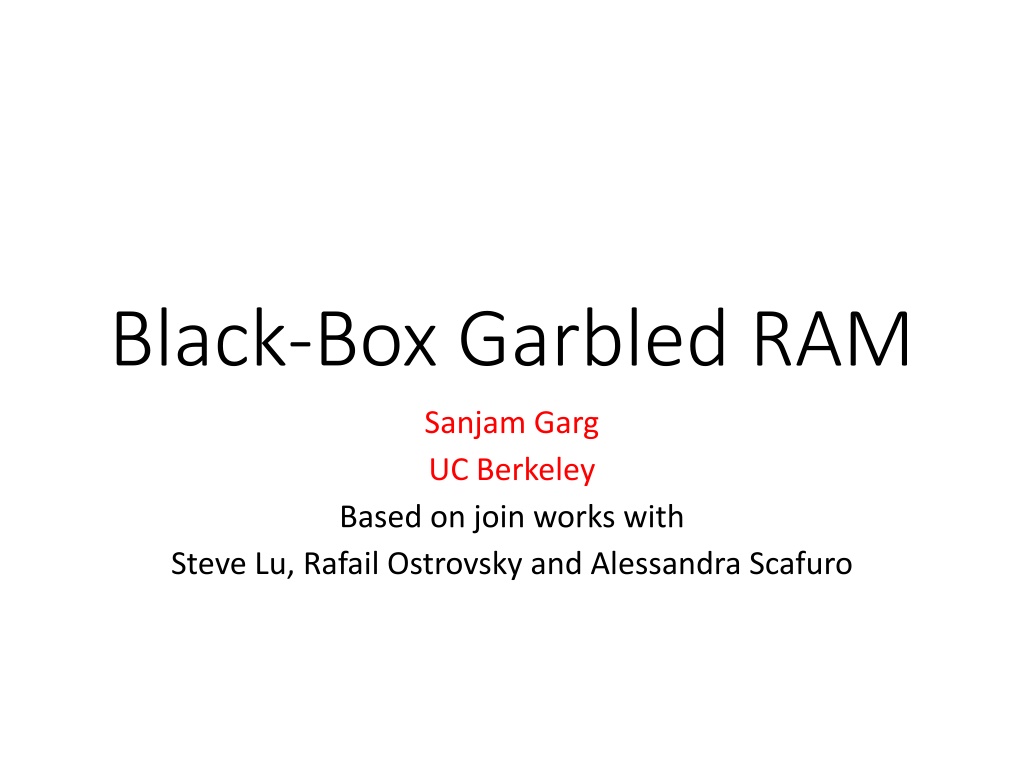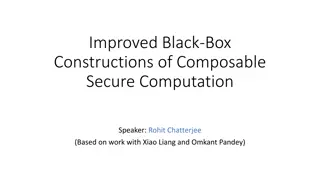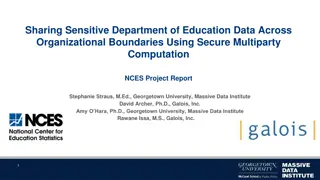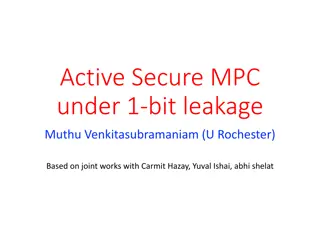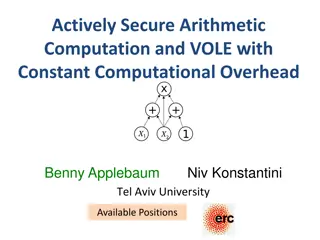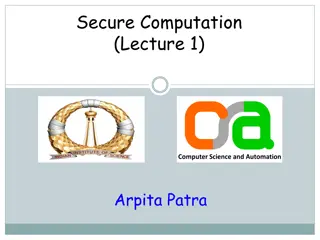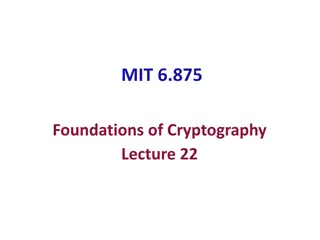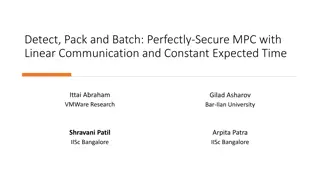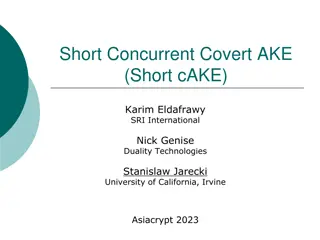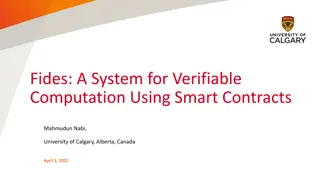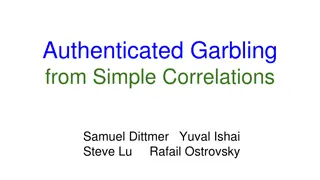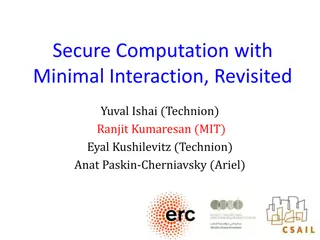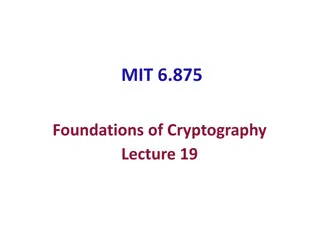Garbled RAM and Secure Computation
Garbled RAM, a concept based on garbled circuits, allows for secure two-party computation with implications for communication and computational complexities. The progression from basic to more ambitious scenarios in Garbled RAM models and the landscape of utilizing OWFs in a black-box manner for improved efficiency are discussed. Technical bottlenecks and high-level construction ideas are explored, shedding light on the RAM model's execution steps.
Download Presentation

Please find below an Image/Link to download the presentation.
The content on the website is provided AS IS for your information and personal use only. It may not be sold, licensed, or shared on other websites without obtaining consent from the author.If you encounter any issues during the download, it is possible that the publisher has removed the file from their server.
You are allowed to download the files provided on this website for personal or commercial use, subject to the condition that they are used lawfully. All files are the property of their respective owners.
The content on the website is provided AS IS for your information and personal use only. It may not be sold, licensed, or shared on other websites without obtaining consent from the author.
E N D
Presentation Transcript
Black-Box Garbled RAM Sanjam Garg UC Berkeley Based on join works with Steve Lu, Rafail Ostrovsky and Alessandra Scafuro
Two-party Secure Computation Yao s garbled circuits
RAM analogue of Garbled circuits Server User ?,? ?,? ?(?) If the running time of the program ? is ? then the corresponding circuit is of size ?3. Communication complexity and computational complexity of both parties grows with ?3.
More Ambitious: Garbled RAM [LO13,GHLORW14] Server User ??,?? ??(??) ??,?? Garbled circuits lead to a solution where the communication and computational cost per program grows with database size. Size of garbled database is ? ? Communication and computation cost grows in ? ??
More Ambitious: Garbled RAM [LO13,GHLORW14] Server User ??,?? ??(??) ??,?? ORAM [Goldreich-Ostrovsky] Full-security: Server learns nothing but the output Unprotected Memory Access (UMA): Server learns Garbled circuits lead to a solution where the communication and computational cost per program grows with database size. access pattern.
Landscape: Garbled RAM Known results make non-black box use of OWFs [LO13, GHLORS14, GLOS15] OWF can t be modeled as a random oracle Focus of this talk: do it using only black-box use of OWFs? Qualitatively better efficiency [GLO15] Not talk about succinct constructions based on iO [CHJV14, BGT14, LP14, KLW15, CH15, CCCLLZ15...]
Outline of the rest of the talk RAM model LO13 approach ([GHLORW13, GLOS15] are similar) Technical bottleneck in realizing black-box construction High level idea of black-box construction [GLO15]
RAM Model next index next index next index read 2 read 1 read 3 CPU step 2 CPU step 1 CPU step 3 Writes require additional work but let s ignore that!
LO13 approach next index next index next index read 2 read 1 read 3 CPU step 2 CPU step 1 CPU step 3 Use garbled circuits!
LO13 approach next index next index next index read 2 read 1 read 3 CPU step 2 CPU step 1 CPU step 3 Translate what is in the memory How do reads work? Access pattern is revealed! 1) garbling memory 2) translate table
LO13 approach STEP 1: garbling of the memory ?? ? ????(?,??) next index next index next index read 2 read 1 read 3 CPU step 2 CPU step 1 CPU step 3 PRF key K to garble
LO13 approach STEP 2: translate table ?? ? ????(?,??) ? next index next index next index read 2 ?0,?1 read 1 read 3 CPU step 2 K CPU step 1 CPU step 3 K K ???(?????,0 ,?0) PRF key K to garble ???(?????,1 ,?1)
Technical Bottleneck The data needs to be encrypted so that the server doesn t learn it! CPU step garbled circuits need to decrypt the read values internally Need of black-box use of cryptography seems inherent
GLO15 high level idea Garbled memory comprises of a collection of garbled circuits with data values hardwired in them Read implemented by a sub-routine call Control flow is passed to memory circuits
GLO15 for one read only ?,?0,?1 ?1 ?2
GLO15 for one read only Say ? = 2 ?,?0,?1 Memory no longer useful! ?1 ?2 Outputs ??2
GLO15 for ? reads only Say ? = 2 ?,?0,?1 How many backups? How do we connect them? Assume uniform memory accesses. ?1 ?2 Outputs ??2
How to connect backups? Problem: Number of keys hardcoded in each circuit needs to keep grow. But not all, because of uniform memory access ? reads can cause an imbalance of ?
Our Fix: Moving window Ensure that next unused children remain in window: Have 1 + ? times the garbled circuits needed and perform artificial consumption if lagging from window. Over-consumption beyond this does not happen
GLO15 for unbounded reads Replenish memory in an oblivious way After ? reads have been performed, memory has been replenished to support ? more reads Add more garbled circuits to each queue! This process can be amortized! ?1 ?2
Security proof - other issues Circularity issue Input labels of one garbled circuit are hardcoded in quite a few other garbled circuits We remove this issue in our final solution Input labels of one garbled circuit are provided by different sources at different times
Conclusion Cryptography for RAM computation Secure RAM computation Typically large round complexity Barrier to efficiency non-black box use Remove this barrier Expect consequences in efficient constructions with weaker security
